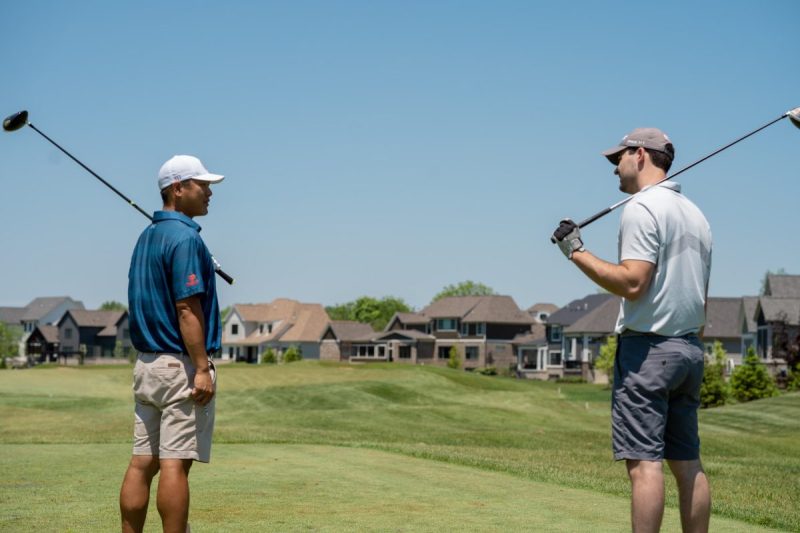Golf lessons aren’t only for beginners. Maybe you need to train for a new course or a tournament, or you have been off your game for far too long, and you need to figure out what is going on with your swing — a few lessons will iron out all of that. But will it be in your budget? If you need to up your swing and lower your handicap, how much are golf lessons to get you there?
Should you take golf lessons?

Before you open your wallet, should you even take golf lessons? Knowing if you need them is step one. If you are starting out, you probably won’t be that good unless you have a bit of beginner’s luck.
If golf will be a long-term hobby, lessons would be worth it. If you are athletic and want to compete in tournaments, golf lessons are a great investment. If you are a weekend warrior on the green and want to impress your friends with your score, golf lessons will help you show off.
Weigh your interest in the sport
In a sport like golf, it doesn’t exactly matter if you have the best clubs on the course if you have no skill or knowledge. The most expensive clubs available won’t show you how to perfect a flop shot. What you want from the game of golf determines if the lessons will be worth it.
Even if you want to golf for fun or relaxation, taking a few lessons to learn the basics properly will help you enjoy it more in the long run. We all need to learn how to play a new sport for the first time, so you might as well learn golf the right way.
Types of golf lessons

You can’t answer how much lessons are without knowing what kind of lessons you are going to take.
- Lessons for children
Junior lessons for the kiddos are available. You can never start too early.
- Group sessions
Group sessions are great for beginners or those who aren’t too advanced yet to learn the rules of the green.
- Group clinics
Group clinics are a more honed, streamlined, focused lesson for specific aspects of the game. You could attend a clinic for a certain skill, like putting.
- Private lessons
You could always take a one-on-one lesson to work on whatever it is you need to.
If private lessons won’t fit into the budget, a more wallet-friendly way to go would be group sessions. But if you have one specific area you want to work on, private lessons focused on that would be more beneficial to your game than attending a group session going over the basics of every aspect. You will have to weigh your financial limit against the needs of where you want your game to be.
What drives the cost of the lesson

How much golf lessons are going to run consists of quite a few variables. If you haven’t yet, sit down and think about what you want out of the lesson.
The length of lessons
How often you take lessons will matter, but how long the lesson is will matter more. You could look for shorter, 30-minute sessions if you aren’t in a rush to improve, but lessons could last up to one hour.
Your instructor’s experience matters
Like with all professions, the experience will affect the asking rate. If you find someone new to teaching, they may offer a lower rate until they have more experience and a wider clientele. Veteran instructors who have a booked calendar months out will charge a higher rate for their expertise.
If you want the best of the best, verify your instructor is PGA-certified. Getting their certification means they went through the whole PGA professional golf management program, and won’t shank it when working on your swing.
Know the equipment you want
Something else to think about is what equipment you want for your lesson. Do you need the latest technology? Do you want to track your ball speed? Know your launch angle? Will you use a slow-motion camera to break down your swing frame by frame? Additional tools and gadgets used will affect the price in an upwards way.
Ask for a discount
Ask about discounts, as some places will give a reduced rate if you sign up for so many classes upfront. There is no shame in wanting to know if the instructor will knock a few bucks off for a certain number of paid lessons.
How much do golf lessons cost?

We know that is a lot of information for the cost of a lesson, but an informed decision is the best. We can only give average rates, as where you live would affect the price.
One lesson should run you between $50 and $100 for a one-hour lesson. You could pick up a 30-minute lesson for $20 to $60. You could grab a deal of six lessons for the price of five. For new instructors, it would be possible to find lessons for $25 for 30 minutes, where experienced instructors could charge up to $150 for one hour. If you have money to burn, celebrity instructors or ones that train the professionals could cost in the thousands for one lesson.
How much do golf lessons cost? The answer takes mental math and knowing what you want from the lessons. Once you figure out the type of lessons you want to take and how often you want the instructor to correct your swing, you can figure out how much lowering your handicap will run you.




